K-wire fixation
1. General considerations
K-wire fixation is optimal for fracture fixation in pediatric patients. In some cases, it can be used in adults with the disadvantage of not producing interfragmentary compression. It also needs longer support with a splint to prevent fracture displacement.
At least two K-wires need to be inserted in a crossing manner for optimal rotational stabilization.
Reduction can be achieved in a closed or open manner. Closed reduction is easier with acute fractures and has the advantage of sparing the hematoma.
There is a high risk of non- or malunion and wire-track infection (osteitis).
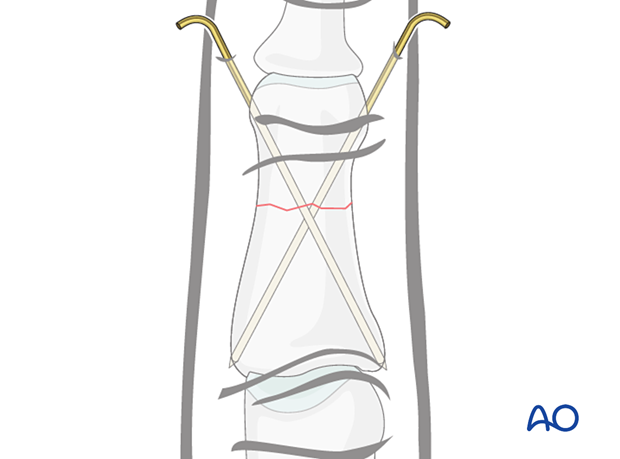
2. Patient preparation
Place the patient supine with the arm on a radiolucent hand table.
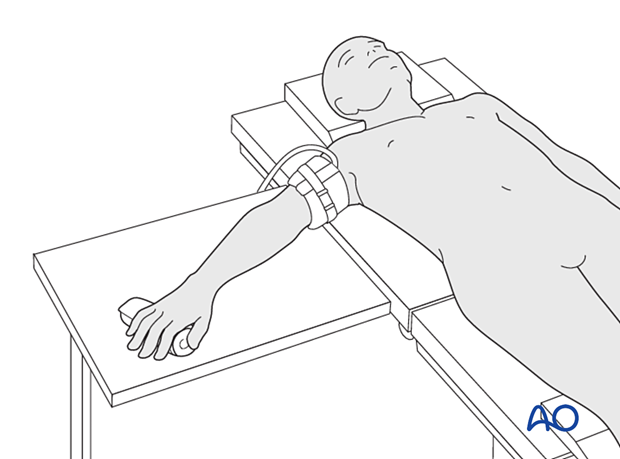
3. Reduction
Reduction can be achieved by traction and flexion of the proximal interphalangeal (PIP) joint exerted by the surgeon.
If the fracture appears stable after reduction, nonoperative treatment can be considered. Confirming reduction with an image intensifier is then essential.
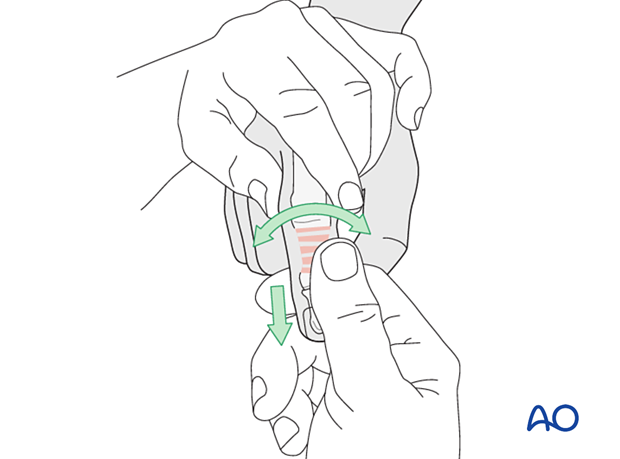
If closed reduction is not successful or in a nonacute case, proceed with an open reduction.
When indirect reduction is not possible, this is usually due to interposition of parts of the extensor apparatus.
4. Fixation
Insert two to three K-wires in different directions crossing the fracture plane through both cortices. The K-wire tracks should not cross each other near the fracture plane.
The wire should be inserted in the coronal plane, to avoid impaling any tendons. Ensure that the point of entry in the side of the finger is dorsal to the neurovascular bundle.
Use a fine drill guide through a small stab incision.
Insert the wire into the far fragment, then confirm reduction before advancing into the near fragment.
Make sure that the tip of the wire engages the opposite cortex but does not project beyond it.
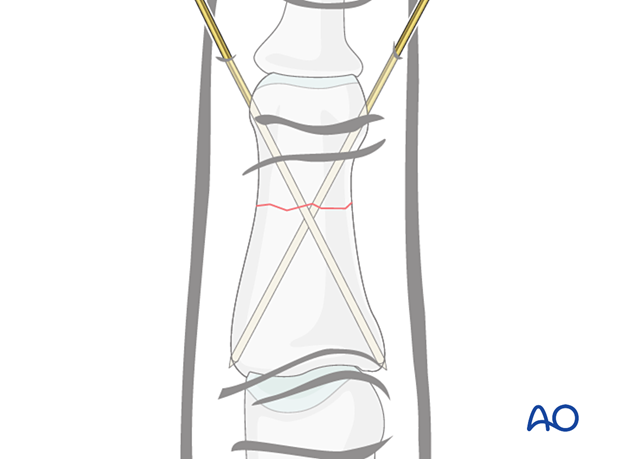
The ends of the K-wires may be left protruding the skin for later removal or buried under the skin.
To protect the skin, bend the K-wire ends with pliers in an L- or U-shape. Leave sufficient K-wire length outside of the skin to accommodate swelling.

5. Checking alignment
Identifying malrotation
At this stage, it is advisable to check the alignment and rotational correction by moving the finger through a range of motion.
Rotational alignment can only be judged with the fingers in a degree of flexion, and never in full extension. Malrotation may manifest itself by overlap of the flexed finger over its neighbor. Subtle rotational malalignments can often be judged by tilting of the leading edge of the fingernail when the fingers are viewed end-on.
If the patient is conscious and the regional anesthesia still allows active movement, the patient can be asked to extend and flex the finger.
Any malrotation is corrected by direct manipulation and later fixed.
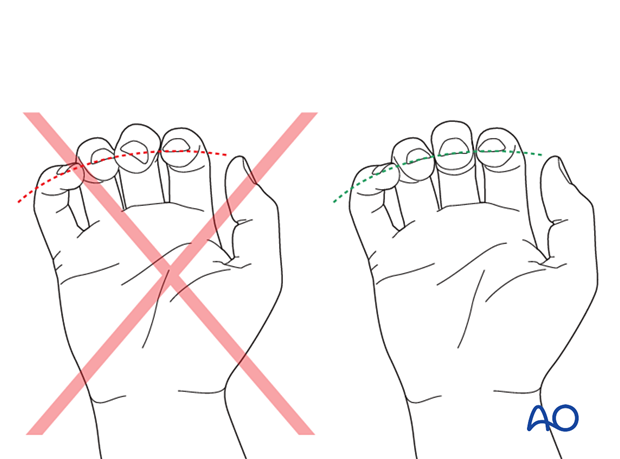
Using the tenodesis effect when under anesthesia
Under general anesthesia, the tenodesis effect is used, with the surgeon fully flexing the wrist to produce extension of the fingers and fully extending the wrist to cause flexion of the fingers.
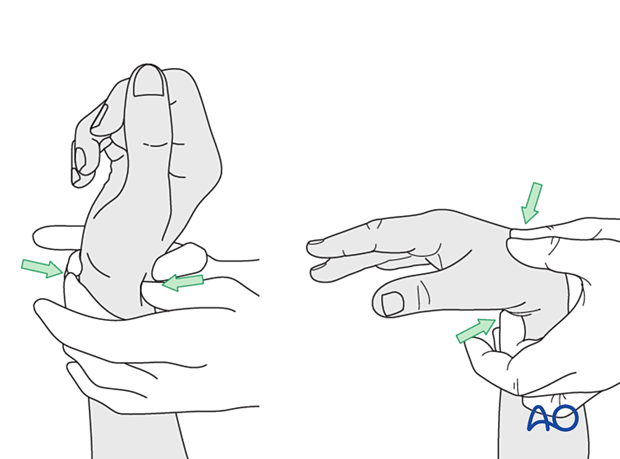
Alternatively, the surgeon can exert pressure against the muscle bellies of the proximal forearm to cause passive flexion of the fingers.

6. Final assessment
Confirm fracture fixation and stability with an image intensifier.
7. Aftercare
Postoperative phases
The aftercare can be divided into four phases of healing:
- Inflammatory phase (week 1–3)
- Early repair phase (week 4–6)
- Late repair and early tissue remodeling phase (week 7–12)
- Remodeling and reintegration phase (week 13 onwards)
Full details on each phase can be found here.
Postoperatively
The hand is immobilized with a dorsal splint for 3–4 week. This should permit movement of the unaffected fingers. The arm should be actively elevated to help reduce the swelling.
The hand should be immobilized in an intrinsic plus (Edinburgh) position:
- Neutral wrist position or up to 15° extension
- MCP joint in 90° flexion
- PIP joint in extension
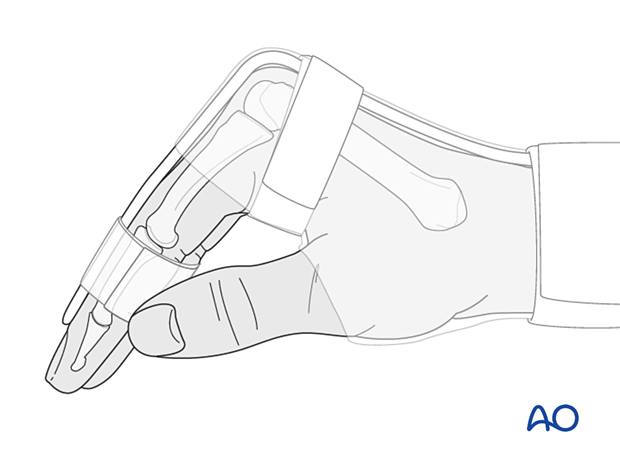
The MCP joint is splinted in flexion to maintain its collateral ligaments at maximal length to avoid contractures.
The PIP joint is splinted in extension to maintain the length of the volar plate.

Follow-up
The patient is reviewed frequently to ensure progression of hand mobilization.
In the middle phalanx, the fracture line can be visible in the x-ray for up to 6 months. Clinical evaluation (level of pain) is the most important indicator of fracture healing and consolidation.
Mobilization
If the fixation is stable enough, the patient is encouraged to take off the splint 2–3 times daily, and to commence with gentle active exercises.
After 3 weeks, the splint is removed, and unrestricted active flexion and extension are permitted.

Implant removal
K-wires can be removed once consolidation of the fracture is visible.












